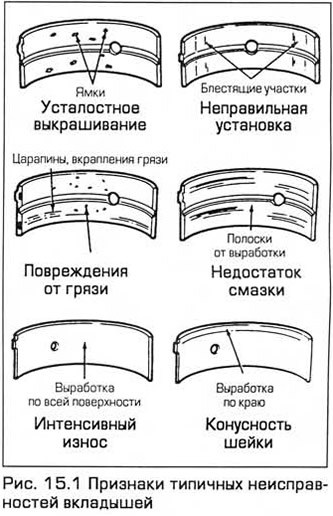
2. Bearing failures can occur due to insufficient lubrication, contamination, motor overheating, or corrosion. Any cause of failure must be corrected prior to engine reassembly to prevent recurrence.
3. At control of loose leaves of bearings remove them from the block of cylinders, rods and covers of lower heads of rods. Lay them out on a clean surface in the same order they had in the engine. This will enable you to match the condition of the bearings to the corresponding crankshaft journal. When checking the surfaces of the bearing shells, do not touch them with your fingers to avoid scratching them.
4. Dirt and foreign particles enter the engine in different ways. They can remain in the engine after assembly, enter the engine through filters or the crankcase ventilation system. They can get into the oil and with it into the bearings. It can be metal filings from machining or ordinary engine wear products. Abrasive particles sometimes remain on the parts after engine repair, especially in case of insufficient cleaning. Such particles are often embedded in the softer bearing material and are easily recognizable. Large particles do not penetrate into the material, but leave scuff marks on bearings and journals. The best way to prevent such malfunctions is to perform a thorough cleaning of all components and parts and to assemble with the utmost cleanliness. It is also recommended to change the oil and filter regularly.
5. Lack of lubrication (or malfunction of the lubrication system) due to several interrelated reasons. Excessive heat (which reduces the viscosity of the oil), overload (which causes grease to be squeezed out of the bearing surfaces) and oil leaks (due to increased bearing clearances, oil pump wear or high engine speeds) - all these reasons cause a violation of the lubrication. Obstruction of the oil passages, which is usually caused by misalignment of the bores in the bushings, also reduces the supply of lubrication and can lead to bearing failure. With a lack of lubrication, which leads to a bearing defect, the bearing material is worn or extruded from the steel base. At the same time, due to overheating, the color of the steel base may change to blue.
6. Driving style has a certain effect on bearing life. The use of wide open throttle modes at low speeds leads to increased loads on the bearings and, accordingly, to extrusion of the oil film. Such loads cause softening of the bearings, which leads to the appearance of filiform cracks on their surface (fatigue failure). In this case, the bearing material is stratified and separated from the steel base. Short trips lead to corrosion of the bearings, because due to insufficient warming up of the engine, water condensate and an aggressive gas environment are formed. These products penetrate the engine oil to form acid and sludge. Therefore, when oil is supplied to the bearings, the acid causes them to corrode.
7. Incorrect installation of bearings during assembly also causes their failure. Tight tightening of bearings leads to a decrease in operating clearance and oil starvation. Dirt or foreign matter under the bushing will cause staining, resulting in a malfunction. When assembling, do not touch the surfaces of the bearings with your fingers, so as not to scratch the surfaces and not to put dirt on them.
Visitor comments